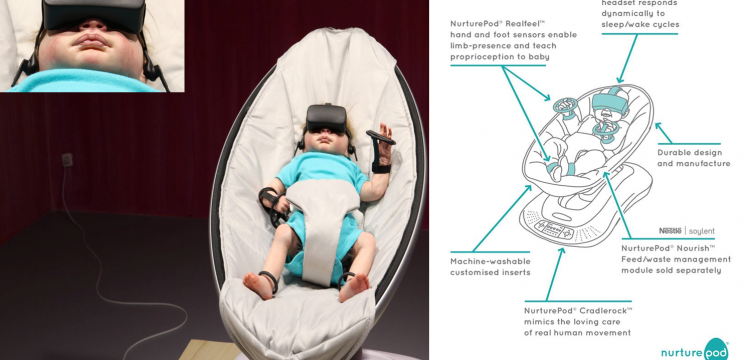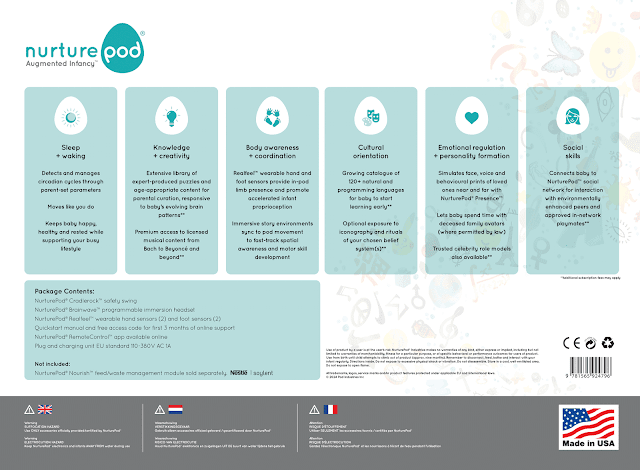Could this be the future of parenting?
This experiential scenario from a not too distant future, my first «solo» art museum installation (really, all this work is highly collaborative), is now live at M HKA, the Museum of Contemporary Art in Antwerp, Belgium.
Futurist/journalist Andrew Curry and I recently had a chance to chat about the project for an upcoming issue of the Association of Professional Futurists quarterly, Compass. Many thanks to Andrew and APF for sharing the transcript below (edited for clarity and length).
https://futuryst.blogspot.com.co/2017/07/nurturepod.html
 Andrew Curry: What we have here is a very small baby –– not a real baby –– in a little pod surrounded by all sorts of digital stimulus looking after her or his needs. This is a «programmable para-parenting pod», which basically removes the need for parents to get involved, as far as I can tell. It’s a bargain at €789, obviously. What was the brief, Stuart?
Andrew Curry: What we have here is a very small baby –– not a real baby –– in a little pod surrounded by all sorts of digital stimulus looking after her or his needs. This is a «programmable para-parenting pod», which basically removes the need for parents to get involved, as far as I can tell. It’s a bargain at €789, obviously. What was the brief, Stuart?
Stuart Candy: The brief for A Temporary Futures Institute was to create some kind of a design contribution corresponding to Dator’s generic images of the future; grow, collapse, discipline or transform, and I was assigned «transform». I had this quite large space and could basically do anything that fit the budget and time. To get from those broad parameters to the final installation really started from the name. There was a prior project (which appeared in Compass) called NaturePod, a hypothetical product from a handful of years away, addressed to stressed-out office workers who may need to reduce their cortisol levels and increase productivity by spending time in nature, without leaving their cubicles. That was a provocative take on what happens when you marry supposedly biophilic interior design trends to virtual reality.
AC: So this is a kind of companion piece?
SC: Right. It came about in a conversation with my longtime collaborator, Jake Dunagan –– a lot of our work is based on wordplay and being silly –– and he said, «well, when you’re done with NaturePod, you should do NurturePod, ha ha ha». He was joking, but I thought it was a brilliant idea. Then this opportunity came along, and I realised that, while this might not be my idea of a transformation, it does actually correspond to a popular notion about what immersion in virtual environments means.
AC: It comes with all this very nice packaging and sales material. Clearly something about the commercialisation of it engaged you.
SC: A lot of the experiential futures work I’ve done is about bringing encounters with futures into an everyday context. Hence guerrilla futures projects like NaturePod; we launched it at an architecture and design trade show, so the people who came across it thought it was real. The organisers of the trade show knew what we were up to, but the thousands of others attending didn’t. I was interested in trying to import the lessons and techniques from creating encounters «in the wild» into the cube of a contemporary art museum. That’s why this piece is not sitting on a white box; it’s sitting on the kind of table you might find in an Apple Store.
AC: The NurturePod box has all the kind of labelling detail you would expect to see in a package. Is that part of the experience as well?
SC: I think the attention to detail that makes a hypothetical resemble the real is an important part of this practice. It is intended to invite, not a suspension of disbelief exactly, but more an investment of belief, a kind of willing desire on the part of the viewer to say okay, suppose that I did come across this in a few years’ time. What do I think about that? What do I feel about that? I think the details provide added dimensions of engagement so they can dive deeper, if they want to. Most people are probably going to engage with the main image; a glanceable, instagrammable baby in a pod wearing a headset. But for those who take the time, there is more detail to enjoy, or be dismayed by, according to your taste.
AC: There’s a little tag, «control baby’s experience with the NurturePod App», and a kind of WiFi, Bluetooth-type logo suggesting I can download it. I haven’t actually tried to do that; I’m guessing that bit might not be real?
SC: That’s right, it does break at a certain point because it isn’t real, but it’s supposed to feel like it is. All of these messaging elements are scaffolded in detail on existing products, and existing idioms that we recognise subconsciously, being citizens of the early 21st century. We’re literate in ways we don’t even realise about the semiotics of marketing, and electronics in particular. This is using that language to get something across about a seemingly imminent possibility.
AC: One more thing that strikes me about this, about the languaging, is it’s not just about marketing. There are a whole lot of cues about the idea of the new, the idea of the modern, and the classic ways in which technology companies make us feel inadequate and then sell us reassurance.
SC: I suppose using those tropes could be said to invite reflection on how embedded in the tropes we are, because we know this particular thing doesn’t exist. But that’s a bit of an intellectual angle. I find people’s emotional responses interesting, from watching them interact with it and from what they’ve shared in conversation.
AC: What sort of things have they said?
SC: «I’m really drawn to this, and also repulsed by it.» There’s this sense of being torn, and that is quite satisfying to hear, because I think creating or inviting a complex emotional response is something that we should strive for in futures work. This is why design and film and performance and games are important –– the whole repertoire of approaches to experiential futures; like the proverbial toothbrush that reaches places regular ones can’t. Hopefully we are on our way to a better futures toothbrush.
(M HKA was also the main venue for Design Develop Transform, where Kelly Kornet and I recently presented the Ethnographic Experiential Futures framework.)
There are some stellar artists featured in ATFI (including Michel Auder, Miriam Bäckström, Alexander Lee and Darius Žiūra), and the other futurists involved in the exhibition are Agence Future (Maya Van Leemput and Bram Goots, Belgium), The Centre for Postnormal Policy & Futures Studies (Ziauddin Sardar and John Sweeney, UK/US), and Mei Mei Song (Taiwan).
Show runs until 17 September –– so if you’re within range of Antwerp, check it out!
See also:
– Article from Harpers Bazaar on what to see at A Temporary Futures Institute
– Show summary from Belgian newspaper De Morgen (in Dutch)
Related:




